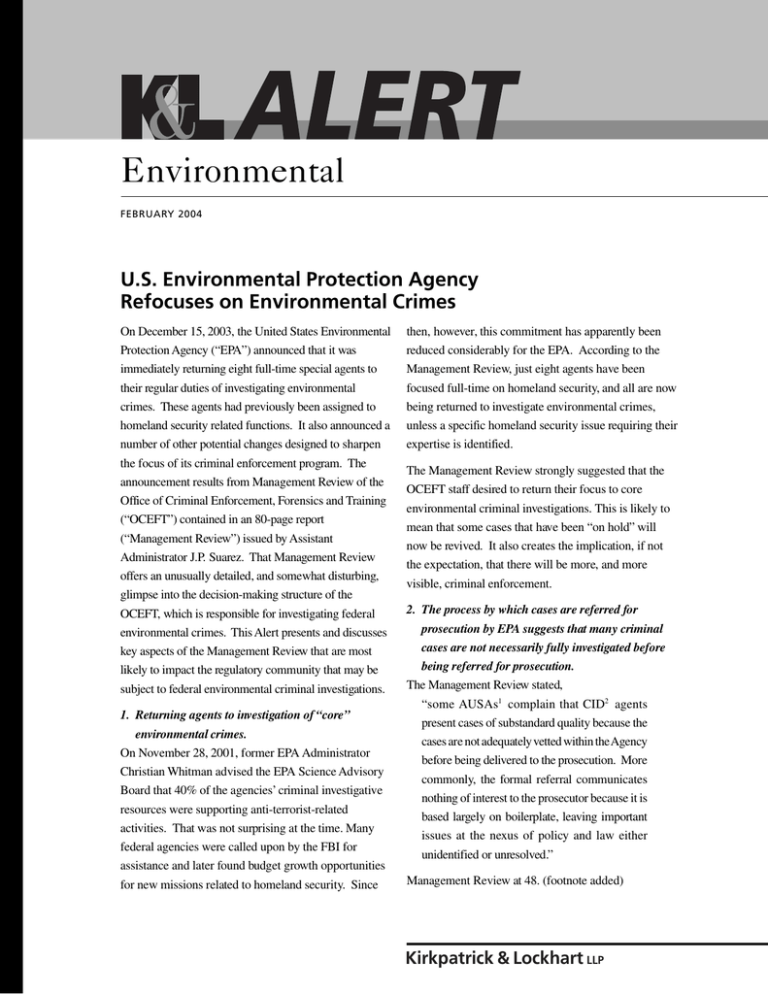
Environmental
FEBRUARY 2004
U.S. Environmental Protection Agency
Refocuses on Environmental Crimes
On December 15, 2003, the United States Environmental
Protection Agency (“EPA”) announced that it was
immediately returning eight full-time special agents to
their regular duties of investigating environmental
crimes. These agents had previously been assigned to
homeland security related functions. It also announced a
number of other potential changes designed to sharpen
the focus of its criminal enforcement program. The
announcement results from Management Review of the
Office of Criminal Enforcement, Forensics and Training
(“OCEFT”) contained in an 80-page report
(“Management Review”) issued by Assistant
Administrator J.P. Suarez. That Management Review
offers an unusually detailed, and somewhat disturbing,
glimpse into the decision-making structure of the
OCEFT, which is responsible for investigating federal
environmental crimes. This Alert presents and discusses
key aspects of the Management Review that are most
likely to impact the regulatory community that may be
subject to federal environmental criminal investigations.
1. Returning agents to investigation of “core”
environmental crimes.
On November 28, 2001, former EPA Administrator
Christian Whitman advised the EPA Science Advisory
Board that 40% of the agencies’ criminal investigative
resources were supporting anti-terrorist-related
activities. That was not surprising at the time. Many
federal agencies were called upon by the FBI for
assistance and later found budget growth opportunities
for new missions related to homeland security. Since
then, however, this commitment has apparently been
reduced considerably for the EPA. According to the
Management Review, just eight agents have been
focused full-time on homeland security, and all are now
being returned to investigate environmental crimes,
unless a specific homeland security issue requiring their
expertise is identified.
The Management Review strongly suggested that the
OCEFT staff desired to return their focus to core
environmental criminal investigations. This is likely to
mean that some cases that have been “on hold” will
now be revived. It also creates the implication, if not
the expectation, that there will be more, and more
visible, criminal enforcement.
2. The process by which cases are referred for
prosecution by EPA suggests that many criminal
cases are not necessarily fully investigated before
being referred for prosecution.
The Management Review stated,
“some AUSAs1 complain that CID2 agents
present cases of substandard quality because the
cases are not adequately vetted within the Agency
before being delivered to the prosecution. More
commonly, the formal referral communicates
nothing of interest to the prosecutor because it is
based largely on boilerplate, leaving important
issues at the nexus of policy and law either
unidentified or unresolved.”
Management Review at 48. (footnote added)
Kirkpatrick & Lockhart LLP
A contributing reason for this is that EPA agents receive
“credit”’ for referrals, regardless of whether the
prosecution is brought or is successful. The fact that
referrals are not as complete as they should be is
surprising, however, since the Management Review also
notes that in every case an investigator develops the facts,
and an attorney in the Office of Regional Counsel
addresses the law. This stands in stark contrast to the
FBI, where agents prepare referrals without necessarily
having the benefit of agency counsel to assist them.
3. Most substantive decisions to refer a case for
prosecution are made by the field agent, with little
or no review by persons having the benefit of
seeing the entire enforcement program.
The Management Review summarized the several
reorganizations that the Office of Criminal
Enforcement has undertaken over its 20-year history.
In 1982, field criminal investigators reported directly to
the Office of Criminal Enforcement in Washington
rather than through Regional Administrators. In 1983,
management of the investigators was moved to Denver,
under the auspices of the NEIC, although legal support
remained in Washington.
Contibuting to this isolation is the fact that tips,
complaints and referrals leading to the opening of an
investigation are typically provided by state and local
law enforcement partners, very few in comparison are
received from the EPA civil enforcement program.
And, according to the Management Review, field
personnel “chafe” against Headquarters management,
even regarding the limited oversight that the Washington
staff exercises over administrative, equipment, and
personnel matters. Management Review at 17. The
Management Review states:
[i]t is also ironic that while Headquarters has
retained control over many seemingly smaller
matters related to budget and procurement,
profound decisions such as whether a criminal
case should be pursued in a specific instance
are largely within the discretion of field SACs.
In contrast to this observation, the Management Review
also notes that field staff perceive decision-making to
be highly authoritarian and centralized, even as to
issues such as search warrant applications and
consensual monitoring. Management Review at 16. It
is not clear how these two observations are squared.
In 1987, some of the management responsibilities were
split between the NEIC in Denver and a new Deputy
Assistant Administrator in Washington. In 1990,
following the enactment of the Pollution Prevention
Act, which required the hiring of up to 220 criminal
investigators, management of the investigators and
legal support were again centralized in Washington,
with agents located in various offices around the nation.
This decentralized review coincides with another trend
- most criminal cases that have been brought over the
last eight years were brought against small companies
and individuals. In the late 1980’s and early 1990’s,
when there was greater substantive review of cases in
Washington, far more cases were brought against large
companies.
In 1993, the NEIC functions were also brought under
more centralized management in Washington, along with
all other criminal enforcement activities. All employees,
with the exception of 90% of the investigators, are
located in Washington. Investigators are in Regional
EPA offices and in other Area or Field offices.
Notwithstanding this centralized management structure,
in practice most substantive decisions on cases are made
in the field, with little or no review by senior managers
in Headquarters or the Regional Offices. Management
Review at 17.
For anyone subject to an investigation, however, both
observations suggest that if there is an effective line of
communication open with the EPA agent early in the
process, it may be possible to provide the agent with
the kind of information that affords a better perspective
regarding how his investigation compares to similar
ones in other regions of the country and whether it is
worth pursuing. This is particularly important since the
Management Review suggests there may well be a
movement toward shifting decision-making from
Headquarters to the Regional Offices, which may result
in less consistent decisions on a national level.
KIRKPATRICK & LOCKHART LLP ENVIRONMENTAL ALERT
4. The OCEFT staff sees reassignment of eight fulltime agents to homeland security related functions
as significantly affecting their mission.
As noted above, eight full-time agents are currently
reassigned to handle homeland security related activities.
Although this represents just 4% of the staff, the
Management Review suggests that the staff of OCEFT
believes this reassignment has had a significant impact
on their ability to investigate core environmental crimes,
even though the number of activities counted, such as
referrals, has remained fairly steady. The Management
Review suggests that in addition to the eight full-time
staff committed to hameland security, far more OCEFT
staff has been involved in homeland security activities, at
least part-time, ranging from response to the anthrax
spores found in the Hart Senate Office Building and
elsewhere, to creating a National Counter-terrorism
Evidence Response Team.
5. There is a disconnect between policy and practice
regarding parallel civil and criminal investigations.
Environmental laws contain civil and criminal
penalties. Because of the relaxed interpretation of the
“intent” standard applicable to environmental crimes,
the criteria used to determine if a case should be
pursued civilly or criminally are unclear. These
decisions seem to be made in the field on an ad hoc
basis without regular coordination with senior level
enforcement managers. In 1990, there was a clear
policy disfavoring pursuit of parallel civil and criminal
prosecutions simultaneously. This was altered in 1994
to encourage more parallel proceedings and closer
communication between civil and criminal
investigators. Curiously, the Management Review
found that there are five civil investigators located
within the CID, and no one could determine why that is
the case.
Persons or entities subject to a criminal investigation
should determine at the earliest possible time if there is a
parallel civil matter being investigated. There are
significant limits on the circumstances under which
criminal information can be shared with civil
investigators, and there are limits on the extent to which
a civil investigation can be used to further a criminal one.
FEBRUARY 2004
6. The lack of trust and communication between
field investigators and central staff is palpable.
Field personnel complained that they are disconnected
from Washington staff and even feared retaliation by
management if they participated in the Management
Review process. In addition, field personnel have filed
more personnel-related claims than other similar
divisions. They also observed that decision-making is
opaque, authoritarian, and arbitrary. Management
Review at 16. In contrast, management in Washington
express concern that “field personnel, left to their own
devices, will pursue activities which are not very
important, fail to produce accomplishments which meet
Headquarters’ objections, or engage in activities
inappropriate to a criminal enforcement program.”
Management Review at 16.
This isolation could have significant ramifications for a
person or entity being investigated. In many criminal
cases, the interpretation of the law or regulation upon
which the investigation is focused may not be settled or
clear. Various EPA Offices or Regions could, and often
do, interpret the same requirement in different ways.
Bridging this communications gap could be crucial to
the resolution of the investigation.
7. Counting “beans” remains a priority of investigators.
The Management Review found that “the desire to
produce favorable traditional enforcement statistics creates
pressures for actions which may not represent the most
strategic use of limited investigative and prosecutorial
resources.” Management Review at v. This confirms the
oft-repeated belief that EPA focuses as much on
maintaining favorable “bean-counting” statistics as it does
on sound law enforcement practices, and that reported
accomplishments may be inflated because a weak or
underdeveloped referral, or simple case gets the same
“credit” as a more fully investigated or complex one. The
Management Review not only confirmed this, but also
reveiled that investigatorial decisions are made most
frequently toward the end of a fiscal year.
The implication of this finding is that investigations
may well be focusing on “easy” and small cases, rather
than more significant ones where there is more
significant criminal conduct.
Kirkpatrick & Lockhart LLP
To overcome the purported isolation from
Headquarters and Regional Offices, the Management
Review recommends, among other things, closer
coordination with EPA’s civil enforcement program,
and “integrated” planning and priority setting with
other EPA Offices and Regional staff. The
Management Review also suggests the development of
a “strategic vision” to sharpen the focus of the criminal
enforcement program, build credibility with
prosecutors, and more strategically select targets for
investigation. Taken together, these recommendations
suggest the beginning of an effort to reshape the
criminal enforcement program to function more like
EPA’s civil enforcement office, which concentrates its
resources on a discrete set of widelyvetted “national
priorities,” such as the NSR utility enforcement
initiative,
ENDNOTES
1 Assistant United States Attorneys. Federal environmental
criminal cases are prosecuted either by AUSAs in the United
States Attorneys offices, or by the Environmental Crimes
Section of the United States Department of Justice, or by a
combination of both.
2
CID is the Criminal Investigative Division - the field agents
who investigate cases. The other components of the OCEFT
are the National Environmental Investigations Center
(“NEIC”) in Denver, which houses state-of-the-art laboratory
equipment for forensic analysis in civil and criminal cases;
the National Environmental Training Institute (“NETI”),
which trains investigators; and the Legal Counsel and
Resources Management Division (“LCRMD”), which is the
administrative arm.
BARRY M. HARTMAN
bhartman@kl.com
202.778.9338
JOHN F. SPINELLO, JR.
jspinello@kl.com
973.848.4061
It is unclear how this Review, which was initiated and
supported by a now-departed Assistant Administrator
for Enforcement, will be implemented. In any event,
however, its contents provide an unusually public
glimpse at the internal operations of a criminal
investigative agency.
FOR MORE INFORMATION about this Alert or Kirkpatrick &
Lockhart’s environmental practice, please contact the authors or one
of the K&L office contacts below. You may also visit our website at
www.kl.com.
Michael DeMarco
Robert Everett Wolin
R. Timothy Weston
Frederick J. Ufkes
Daniel A. Casey
William H. Hyatt, Jr.
Warren H. Colodner
Richard W. Hosking
Edward P. Sangster
Barry M. Hartman
Boston
617.951.9111
Dallas
214.939.4909
Harrisburg
717.231.4504
Los Angeles
310.552.5079
Miami
305.539.3324
Newark
973.848.4045
New York
212.536.3912
Pittsburgh
412.355.8612
San Francisco 415.249.1028
Washington
202.778.9338
mdemarco@kl.com
rwolin@kl.com
tweston@kl.com
fufkes@kl.com
dcasey@kl.com
whyatt@kl.com
wcolodner@kl.com
rhosking@kl.com
esangster@kl.com
bhartman@kl.com
®
Kirkpatrick & Lockhart LLP
Challenge us. ®
www.kl.com
BOSTON
■
DALLAS
■
HARRISBURG
■
LOS ANGELES
■
MIAMI
■
NEWARK
■
NEW YORK
■
PITTSBURGH
■
SAN FRANCISCO
■
WASHINGTON
.........................................................................................................................................................
This publication/newsletter is for informational purposes and does not contain or convey legal advice. The information herein
should not be used or relied upon in regard to any particular facts or circumstances without first consulting a lawyer.
© 2004 KIRKPATRICK & LOCKHART LLP.
ALL RIGHTS RESERVED.





